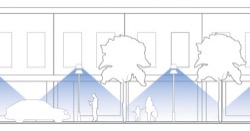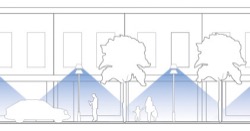On this page:
Importance of lighting in urban design
Lighting performs a number of functions, from supporting way finding, orientation and safe movement at night to providing a decorative effect for building facades, landmarks and paths.
Lighting systems can be large scale and utilitarian or small scale and ornamental. They may use overhead lamps, bollards, up–lights, bulkhead or veranda lighting, feature and facade illumination. Shop display lighting can also contribute to overall public realm lighting levels.
Well located lighting can enable the use of public spaces for active recreation during the evening, especially in winter.
These guidelines focus on public space lighting design for safety and amenity.
6.5.1: ensure lighting supports night–time social and recreational activity, amenity and safety in the public realm
Path and street lighting should meet Australian Standard 1158 Road Lighting as a minimum.
- Locate lighting for safe travel and way finding along pedestrian and bicycle paths, and to emphasise crossings, landmarks and destinations.
- Light only those public space areas and paths intended for night use.
Tip: absence of lighting can identify areas to avoid.as a minimum,
- Provide lighting on all pedestrian and bicycle path approaches to and through activity centres.
Tip: in activity centres, lighting levels can be higher than surrounding areas.
- Where pedestrian and bicycle paths pass through public open space, light the paths to the same level as surrounding streets.
- Where a path passes through an underpass, light the approach and exit path to the same level as the underpass.
Tip: long underpasses and tunnels may require lighting during the day.
- Locate lighting at points of potential pedestrian–vehicle and pedestrian–bicycle conflict.
- Locate lighting in social spaces used at night for recreation, cafes or events.
- Provide lighting at public transport stops, pedestrian refuges and median openings, bicycle parking hoops, way finding signs, and payphone cabinets.
- Light the interiors of public transport shelters to the same level as surrounding area and approach paths.
Tip: consistency between lighting at public transport stops and surroundings will mean surroundings do not seem dark by contrast.
- Install lighting at building entrances and car parking vehicle exits.
6.5.2: ensure lighting contributes to local character and cultural values
- Use external lighting to enhance the appearance of a building or landscape feature.
- Integrate lighting with signs, landscaping and other public space elements.
6.5.3: ensure lighting aids night–time way finding
The overall lighting level in public spaces may comprise light from a combination of sources including street lights, signs, adjacent shops and buildings.
- Provide consistent, continuous lighting levels along paths.
Tip: infrequent large, single point lights can result in glare and unilluminated patches, and are detrimental to people with visual impairment.
- Use lighting types that minimise distortion and glare, and maximise colour recognition of objects and surfaces.
Tip: white light lamps provide better colour rendition and object recognition.
- Place lighting poles and lamps away from tree canopies, verandas and overhead wires.

Tip: where a street is narrow, light fittings may be fixed to building walls or suspended from catenary wires to minimise pedestrian path obstruction. - Direct the path and activity lighting downwards to illuminate the immediate surrounds.

Tip: lights placed at eye level can prevent pedestrians and cyclists from seeing beyond the light source. - Where lighting bollards are adjacent to pathways, direct the light beam downwards.
Tip: unhooded light bollards can cause glare for pedestrians, limiting visibility into the distance.
- Provide lighting levels that enable recognition of an approaching person’s face from 10–15 metres away.
Tip: strong light sources produce deep shadows and can reduce local visibility and surveillance.
6.5.4: ensure sensitive uses adjacent to public spaces are protected from light spill
- Control unwanted light spill to sensitive uses from public space lighting.
Tip: avoid lighting that shines upwards to limit general light pollution.
- Provide a gradual transition between bright–lit and dimmer–lit areas.
Tip: over–lighting an area can create the impression that surrounding places are under–lit.
6.5.5: ensure effective management and maintenance of public space lighting
- Establish a standard design for public space lighting elements.
Tip: consistent use of standard details and parts supports efficient management and maintenance.
- Use low–energy, long–life, high–colour rendering index, glare–controlled light fittings.
- Maintain established trees foliage clear of path lighting.
Page last updated: 09/06/23